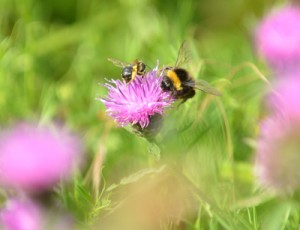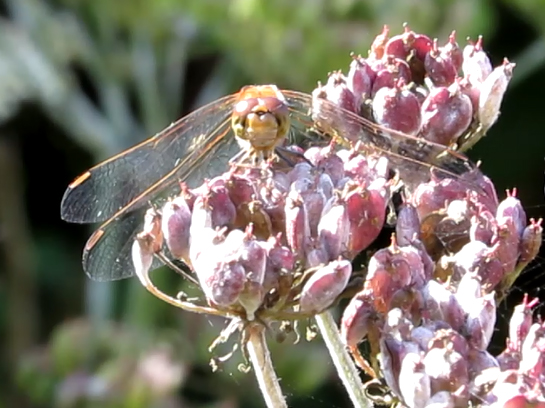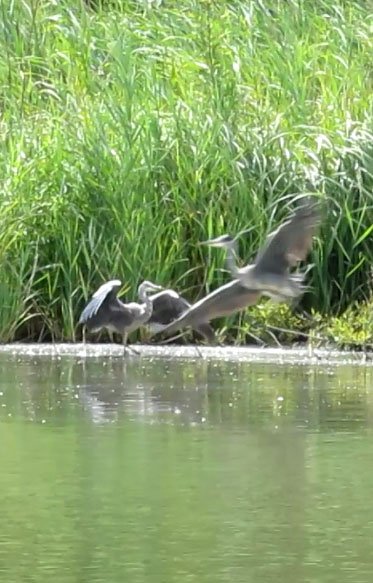Heron squabble at the Scrape Hide
Wildlife Sightings column for August 22 Observer Newspaper series
It was a little cooler last week but still warm enough to create a paradise for plants and insects on the reserve. Willow herb is standing over 5 feet tall in many places. Teasel is in flower, its delicate tiny lavender flowers a contrast to the spiky heads in which they sit.. Burdock has also started flowering with pinks heads showing on its round burrs. Near the Holt building the garish purple flowers of black knapweed have attracted a crowd of bees including a mining bee, its legs yellow with pollen, and a large queen cuckoo bumblebee. The cuckoo queen will enter a bumblebee nest, laying her eggs there for the workers to care for.

Bistort is having a good year, these small clubs of pink flowers prefer damp soil. Purple marshmallow is flowering on the islands in Wetland Discovery and near the Pond Skater play area. In the wet meadow I see patches of red bartsia, a semi parasitic plant that like gets nutrients from the roots of its nearby grasses. If you are interested in wetland plants, their historic uses and medicinal properties you can learn more from Sheila, our medieval herbalist on a Summer Plants walk each Thursday in August.
At Ramsar Hide it is nice an quiet now that the black headed gulls have finished beeding and moved on. A sedge warbler plunges into the trees on the right of the hide carrying food likely feeding young. I count eight greylag geese and three teal. I see a black tailed skimmer and common darter dragonflies over the water. The reddish common darter and apple green southern hawker dragonflies are emerging now in late August.

Back on the pathway butterflies are abundant. Opposite the Tundra pen I watch a female common blue egg laying on birds foot trefoil in a sunny patch just off the ground. Small whites, red admirals and common blue flit through the wet meadow near the boat jetty. A family of goldfinch drops from trees and skips over the water to land on willow in the Tundra pen.
On my way to the Scrape Hide I hear a buzzard calling over the hangar. The buddleia at the gate has two small tortoise shell butterflies, two peacocks and two red admirals. I watch a long horned beetle feeding on an umbelliferae beside the hedgerow. In the woodland loop I spot some long-tailed tits in the trees by the wet meadow. A juvenile bullfinch sits high in a tree calling giving out two low notes as a contact call.
At the Scrape hide I count eleven wigeon and eleven gadwall. I watch a juvenile grey heron wading along the back edge of the water looking for fish. Another adult grey heron walks out of the reeds into view behind him; the juvenile turns around and eyes the intruder. There is a tense standoff before the juvenile flies at the adult, to drivbe him off his territory. The dangling legs and long wing flaps of the herons make this challenge look as if its in slow motion and slightly comedic. The juvenile drives the adult off then takes to the air to chase him for good measure.

An insect post on the side of the visitor centre building is part of the nest box display. A leaf cutter bee has been hard at work sealing eggs and food inside holes drilled for nesting, some of these plugs still show green where the chewed leaves are fresh.

